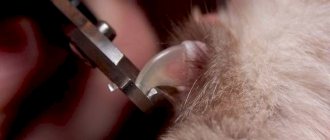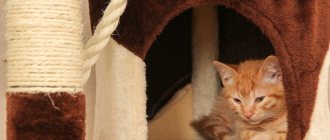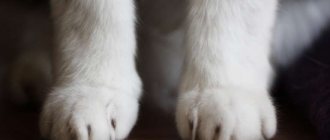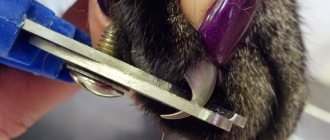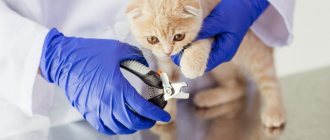Trimming a cat's claws at a veterinary clinic is one of the most popular services among our specialists.
In their natural environment, animals usually wear their claws off on tree bark, soil, or other covering. However, only a small percentage of indoor cats have free access to the outdoors. Therefore, in order to solve the issue of correcting the length of claws, many pet owners install various types of scratching posts in their apartment. But, unfortunately, cats are not always favorable to these devices and often prefer upholstered furniture, wallpaper and door frames to them.
Thus, trimming cats' claws at a veterinary clinic is the best way to control their length and maintain the health of the animal's paws and the owners' nervous system.
Why trim your cat's claws?
The joy of acquiring a furry neighbor is often replaced by concerns about the animal’s behavior. If a cat has not been accustomed to a scratching post since childhood and is inclined to swing its paw at the owner’s hand, there is a risk of getting an unpleasant surprise in the form of frequent scratches. Trimming cat claws is necessary and can be done at home:
- If your pet has an increased interest in furniture, this can completely ruin a sofa, armchair, set, or even renovations.
- If the pet has an aggressive character and has repeatedly scratched and injured its owners, family members and guests.
- If your pet is participating in shows: show breeds (British, Russian Blue, Maine Coon) may be disqualified for having untrimmed nails.
- There are pathologies in which animals have deformed phalanges and claws that grow into the paw pads. In this case, trimming the claws is a necessary procedure.
IMPORTANT: claws are an important tool of feline nature. Animals use their claws to hunt, climb to surfaces, and defend themselves. Completely declawing a pet is inhumane and unsafe for the animal's future life.
Nail trimming is a safe and necessary procedure for indoor cats.
Price for nail trimming
| Name of veterinary services | Unit | Price, rub |
| ⭐ Nail trimming | 1 animal | 300 |
| ⭐ Beak trimming | 1 animal | 300 |
| ⭐ Cleaning the anal glands | 1 animal | 300 |
| Hygienic cat grooming (with removal of mats) | 1 animal | 2000 |
| Sanitary animal grooming: | ||
| – small animals (up to 5 kg) | 1 animal | 1650 |
| – medium animals (over 5 kg to 15 kg) | 1 animal | 2750 |
| - large animals | 1 animal | 4400 |
| Sanitary washing of animals: | ||
| – small animals (up to 5 kg) | 1 animal | 550 |
| – medium animals (over 5 kg to 15 kg) | 1 animal | 3300 |
| - large animals | 1 animal | 5500 |
CLINIC REGISTRATION
HOME CALL
Preparing for your first haircut
Trimming nails should become a familiar procedure for your pet from an early age. You should periodically pick up the kitten in your arms and, pressing slightly on the pads of its paws, allow it to release its claws, while simultaneously massaging its paws. Over time, when the kitten begins to calmly respond to manipulation, it will be useful to reward it with treats, thereby reinforcing the positive habit.
IMPORTANT: a kitten should have its claws trimmed when it is 2 months old.
Ideally, the pet should be indifferent to the procedure.
The procedure can only be carried out when the animal is in a completely calm state. It is strictly forbidden to use physical force and raise your voice at your pet, but it is still necessary to show persistence: there is a chance that the pet will begin to worry and break out.
Talk affectionately, pet and treat your pet, and enlist the help of someone who can hold the animal. Do not insist on the procedure if the cat screams loudly and breaks out, this is fraught with psychological trauma and severe stress. Be patient if you want to make bone trimming a habit in your pet's life.
Why does a cat bite its nails?
Sometimes you can witness how cats, like people, bite their nails. Often such actions are perceived as an element of self-care - the cat thus gets rid of the old stratum corneum - the so-called “case”. Or the nail has grown so much that it already causes discomfort and the cat gnaws it. Usually, the listed problems are easily solved by the cat on its own, by grinding its claws on furniture or other surfaces in the house. However, this may not be enough for pets. Here you will need the owner's help to trim your nails. There are also other, more serious reasons for this behavior in cats.
Paying attention to your pet's behavior is the key to its health
The first reason is being in a stressful situation. There can be many reasons for stress in an animal. This includes the appearance of a stranger in the house, a change in the usual environment, be it a move or a trip, and any violent actions towards the cat. At the same time, the animal may not understand the true meaning of actions directed towards it. These types of actions include: taking medications, washing the cat, treating wounds and other similar procedures. The point of these manipulations is to take care of the health of your four-legged pet.
Pets with free access to the street are no strangers to stressful situations - attacks from stray dogs, the chance of getting run over by a car, and simply the possibility of being harmed by people who can harm the animal. If you have not previously observed a cat biting its nails, you should analyze what possible events preceded this.
Haircutting tools
First of all, to successfully perform a cat manicure, you need to acquire a tool. In specialized pet stores and veterinary pharmacies you can find all the equipment necessary for the procedure:
- Nail clipper-scissors. In appearance it resembles ordinary nail scissors, but with notches on the blade. It is in these grooves that it is convenient to insert a cat's claw so that it does not slip. The device allows you to quickly and evenly shorten claws.
- Trimmer in the form of a guillotine. The tool resembles pliers with a ring instead of blades. The trimmer is easy to use and very popular among experienced owners. Beginning cat breeders may have difficulty determining the length of the claw to cut.
- Nail clipper. The device is safe to use, as it has a locking system that prevents the blades from closing.
- Veterinary clinics and animal care salons use electric nail clippers, which are classified as professional tools.
Nail trimming tools
In a wide selection of cutting devices, the owner is often confused about how to trim a cat’s claws. If you have little experience in this procedure, then you should choose a nail clipper or scissors. The choice of tool also depends on the condition of your pet’s claws. If they are thin and transparent, then scissors or pliers will do the job, but if the claws are dense and thick, then a guillotine trimmer will be the best option.
At home, you can also use nail scissors or clippers to perform the procedure. In addition to the cutting tool, you will also need a hard nail file or emery block for correction after trimming. Just in case, you need to arm yourself with cotton swabs and 3% hydrogen peroxide.
Useful video
Video on how to properly trim a cat's claws:
If you accidentally cut the living part of the claw or the skin on the pad, then the main thing here is not to panic. If there is a small amount of blood coming out, just gently treat the bleeding claw or wound with hydrogen peroxide and calm the offended pet.
If, without keeping an eye on your pet, he jerks unsuccessfully and the bleeding from the wound is abnormally strong, immediately cover the cut with a clean piece of tissue and take the cat to the veterinarian.
Age and purpose
Cats are pets that are often kept at home, so you need to know the basic requirements for caring for them. Since animals are wild and capricious by nature, the presence of sharp claws can be quite dangerous for others. To minimize risks, you need to be able to trim a cat's claws if the need arises.
There are the following reasons why this procedure is mandatory:
- keeping a cat exclusively at home;
- lack of significant activity in the animal’s behavior;
- assistance in grinding down claws if the pet cannot do it on its own;
- too violent and unbridled character, which threatens the health of others.
If in the first three cases the manicure procedure is desirable, then in the last one it is necessary to trim the cat’s claws, because anyone can get hurt, including children. The procedure for shortening the nail plates can be carried out on all four paws so that the cat does not feel discomfort, understanding the difference in sensations in front and behind, and is also completely harmless. If the pet does not show aggression, then trimming and filing the claws on the hind legs can be omitted.
It is not recommended to do this procedure too often, as this can negatively affect the cat’s health. There are also certain age limits when it is worth starting such procedures in order to accustom your pet to them and not have problems with it in the future. The optimal period would be the age of two to three months, when the claws have already become stronger and can be cut off, and the pet is still small enough to protest, but is quite capable of gradually getting used to the manicure.
Carrying out similar actions for smaller kittens is harmful, since their claws are still too tender and you can cause pain to the pet by cutting them too much.
You can cut the nail plates of a cat or kitten only if you have some experience or knowledge of how the process itself should be carried out correctly. The first time is always the most difficult, both for the cat and for the owner, so it is important to prepare mentally and create all the conditions for the work to be carried out successfully. To keep the kitten from getting nervous, you need to pet it, talk to it, and treat it to something tasty. The procedure will no longer be scary and unpleasant for the animal when it feels safe and expects a reward after the manicure is completed.
Once the procedure has become habitual for your pet, it is worth deciding on its frequency so as not to worsen the condition of the claws and not to overdo it with shortening them. For each cat, the number of such sessions may differ, which is explained by individual developmental characteristics, activity level and age. The optimal norm is to trim claws once a month.
If we talk about kittens, then they are actively growing not only their bodies, but also their nail plates, and therefore they will have to be shortened 2 times more often.
All claws in one session, or one paw every day?
Everyone chooses a nail trimming scheme according to their own employment and the level of patience of the animal. How to trim a cat's claws in one fell swoop if she gets nervous and struggles? A short-term procedure in this case is impossible a priori, since everything may end with more or less neatly trimmed claws, but an unpleasant side effect can manifest itself in the form of irritation of the owner and severe fright of the animal.
After treating the claws, you need to praise the cat for its endurance
More humane, although it takes much longer, would be to repeat the procedure every day - it takes much less of the owner’s nerves per paw, and the cat will get used to the procedure in 4 days and will behave much calmer.
After treating the claws, you need to spend some time with your pet, praise him for his endurance (animals understand this very well), play with him, and treat him with a treat. This way, the animal will not develop a final and irrevocable aversion to trimming its claws - it will be interested in the process being completed as quickly and efficiently as possible, because it is followed by a reward.
If you notice blood on a claw, you should not panic
How to prepare for the procedure
The owner must know how to prepare for pruning. Most pets initially resist pruning with all their might. It is important to properly prepare your animal. It is better to choose a time when he is relaxed and in a good mood. You need to start with a paw massage so that the pet does not feel discomfort. Attention switches to other activities and objects.
In the first months, the kitten experiences fear, fear and even irritation. It can break free and run away, and if held by force, it can even bite or scratch a person.
You should not use physical force, as it is necessary to convince your furry pet that this procedure is absolutely safe for him, that he has nothing to be afraid of. Trimming should be done regularly; the animal will gradually get used to it.
Over time, a habit will appear, and to make this happen faster, you can use encouragement in the form of something tasty. In order for pruning to be taken calmly, you should not expose your pet to stress. The owner should talk to him affectionately and stroke him. If the cat is too scared, it is better to postpone the procedure.
What not to do
It is also important to consider that some manipulations can be harmful to the health of the pet.
Do not do it:
- Place the cutting tool parallel to the nail plate, as this can lead to delamination.
- Skip the next manicure session.
- Trim an animal's claws if it is nervous, breaks out, or is aggressive. In such a situation, you can accidentally hurt or injure your pet.
- When pruning, do not touch the pulp, because bleeding and subsequent improper treatment can cause an inflammatory process.
- Carry out the procedure with blunt instruments. This is fraught with problems in the form of delamination or breaking of the claw.
- Plan several different activities related to pet hygiene for one day. This can negatively affect the cat's psychological health.
How to trim a cat's claws yourself?
Preparation begins at the moment when the animal does nothing: does not eat, does not sleep, does not play and does not lick itself. Take your pet in your arms, talk affectionately and communicate. Lightly touch the paw pads, massage them, while trying to distract your pet's attention. It is advisable to enlist the help of someone whom the cat knows and trusts.
- Place your pet on a stable surface.
- Take the paw, gently massage and press on the pads, do this with each paw.
- If your pet reacts well and doesn’t break out, give him a treat.
Below you will learn how to trim a cat's claws using scissors and a nail clipper at home.
How to properly trim a cat's claws with scissors at home
Prepare:
- Scissors (blister)
- File
- Cotton pad
- Hydrogen peroxide
Before the procedure, wash your hands, clean and disinfect instruments.
The pink part is the vessels and pulp
- Carry out the procedure in a room with good daylight.
- Sit comfortably and place the cat on your lap, stroking and calming your pet.
- Take the paw in your hand, massage it, and as soon as the cat releases its claws, start trimming.
- After trimming your pet's claws, treat them with a file so that the animal does not cling to surfaces.
The photo shows a diagram of how to properly trim a cat's claws without damaging the pulp.
IMPORTANT: take special care if the cat’s claws are black - leave extra length for safety.
Do-it-yourself haircut with a nail clipper
A nail clipper allows you to safely trim your nails to the desired length. Using a nail clipper, it is almost impossible to accidentally injure an animal, but you should cut carefully so as not to touch the blood vessels.
Prepare:
- Claw clipper
- File
- Cotton pad
- Hydrogen peroxide
Before the procedure, wash your hands, clean and disinfect instruments. Next, follow the familiar instructions:
- Choose a well-lit room.
- Sit the animal on your lap, calm and stroke it.
- Allow your cat to release her claws by gently pressing on the pads of her paws.
- Carefully guide the movements of the nail clipper at the correct angle so that after the procedure the claw resembles an “arrow”.
You can leave extra length to be on the safe side.
Accustom and prepare your cat for trimming
When a pet from an official nursery appears in the house, questions usually do not arise.
All training and preparation boil down to ensuring that the cat sits calmly in your arms; for this, we often pick it up, stroke it, and massage the paw pads. To make her friends with the nail clipper, let her sniff and touch her. The animal should be fed before the procedure; it should not be cut after playing. For the cat, the process should be calm and painless.
How to properly trim your nails at home
Trimming rules:
- The nail cutter should be positioned parallel to the claw, not at an angle or across, otherwise the cut will break the claw, resulting in peeling;
- We retreat from the pulp 2-3 mm;
- We make a cut at an acute angle, as shown in the figure;
- Cut off no more than 2-3 mm of the stratum corneum, 1-2 mm on the lower paws.
The photo below shows the rules for trimming claws, at what angle it is correct to do it, and where the sensitive (dangerous) area is located.
Alternative Methods
If your cat categorically refuses to get a pedicure and it is inconvenient to take him to the veterinary clinic every month, you can consider alternative methods:
- Anti-scratch. Special overlays (caps) prevent damage to the furniture, but it is uncomfortable for the animal to walk, and the horny plates still grow and need to be cut off.
- Onychectomy or soft paw surgery. A difficult procedure for the animal, during which part of the cat’s fingers is taken away. Animals' paws become deformed, they lose coordination, and suffer from pain. Condemned by many veterinarians and breeders. In a number of countries the operation is prohibited.
How often to trim nails
Experienced breeders who are interested in how often to trim a cat's claws advise trimming them as they grow. Typically this procedure should occur once every 10-14 days. But this is a common opinion, and in fact, the frequency of claw trimming will largely be determined by third-party factors:
- personal characteristics of the body (speed of nail growth);
- color of the nail plate (light nails grow faster than dark ones);
- activity of the cat (more frisky animals, often playing in the apartment or spending time outside, take care of the sharpness of their claws, regularly sharpening them, as opposed to their lazy relatives, who often spend time half asleep).
- No one can say with certainty how often to trim a cat’s claws, so in each case it is necessary to determine the frequency of trimming on an individual basis.
It is a common belief that the claws on the hind paws do not need to be trimmed. You should not check the correctness of this statement on your own furniture.
If a cat is participating in an exhibition or is about to be bred, it is imperative to trim its claws the day before.
General recommendations for the frequency of nail trimming
- Animals leading an active lifestyle, who run a lot, play and use a cat scratching post, should have their nails trimmed no more than once a month or even less often.
- Old or lazy cats that move little and mostly lead a sedentary lifestyle should have their claws trimmed twice a month.
Why do you need to cut your hair?
Animals mainly choose door frames, furniture, and wallpaper to sharpen their claws. Trying to protect their property, breeders buy scratching posts, make scratchers themselves, take the cat to a groomer, or master the grooming technique themselves.
However, besides damaging things, there are other good reasons for trimming your cat’s claws:
- ingrowth of horny formation into soft tissue.
- injury to blood vessels and nerve endings;
- delamination or disruption of the claw plate.
Most often, the problem is caused by the fifth toes, which are located slightly higher than the rest. They are not used by cats every day, but are used only for climbing on vertical surfaces. In pets, such claws can grow into the skin. At the site of ingrowth, the inflammatory process quickly begins due to the penetration of bacteria. Other, heavily grown claws can also damage the pads. This happens when walking. It is difficult for a cat to hide long processes, and the pressure when walking forces the claw to curl inward.
Long sharp claw plates cling to everything they can. The cat, trying to free himself, often tears them off completely.
What should you do if your cat doesn't want her nails trimmed?
Not all cats like having hygiene procedures performed on them, especially nail trimming. Some of them may be nervous, grumble, wag their tail threateningly, and some even strive to scratch or bite their owner. Therefore, if a cat shows particular aggression during a haircut, then you need to follow certain rules and recommendations in order to carry out the procedure safely:
- The grooming procedure should be done at a time when the cat is most calm and peaceful.
- Before trimming a cat's claws, you can swaddle him - this will save the owner's time, and he will remain without scratches or bites.
- You need to constantly pet the cat and speak kind words to it to relieve excess stress and aggression.
- Claws need to be trimmed when the animal has completely released them from the pads.
- After trimming the cat's claws, you need to give it its favorite food or something tasty.
Is it possible to cut while the animal is sleeping?
Trimming the claws of a sleeping animal is not recommended. As a rule, cats are very sensitive animals and they also sleep lightly. During sleep, an animal can be easily frightened, and this can become very stressful and have unpredictable consequences: the cat will begin to be afraid of you and avoid you, in the future it will not allow you to touch its paws, much less cut its claws.
To carry out the nail trimming procedure, your pet must be as calm as possible, but in no case defenseless.
What to do if blood comes from the claw
Rarely does a haircut succeed without incident - either the cat twitched, or the hair was too long. The main thing is to be prepared for anything. What do veterinarians say?
At home, only hemostatic powder or dry potassium permanganate are available. She can only stop the bleeding on her nails, but not on her skin - it risks a chemical burn.
In all cases, not excluding the above-mentioned bleeding, veterinarians are of the opinion that the care was professionally provided.
It is better not to carry out such procedures on your cat yourself - or first get advice and advice from a veterinarian.
If a vessel is hit
If the cat gets nervous while trimming its nails and constantly tries to jerk its paw, a blood vessel may be damaged.
On a note! Having noticed blood on a claw, you should not panic and invent non-existent horrors - up to and including the development of gangrene in the animal.
Nothing like that will happen - the injury is equivalent to a small cut on a person.
If bleeding does not stop, contact your veterinarian
But it is necessary to prevent germs from getting into the wound - to do this, just rinse it with hydrogen peroxide or any alcohol-containing product. If the bleeding does not stop within 40-60 minutes, you should contact your veterinarian.
Is it necessary to remove claws?
Don't remove the claws! During onychectomy, not only the plate is removed, but also the phalanx of the finger from which it grows. Only a very young cat can survive surgery without consequences, and the procedure itself carries many risks.
Among them:
- blood loss;
- infection;
- nerve deformation;
- disturbance of gait, balance, coordination due to the fact that the pet will be forced to step on the pad and not the fingers;
- deterioration of character due to the fact that the cat feels vulnerable and unable to defend itself.
Instead of removing the plate, trim it regularly, use a scratching post. If you don't have time to trim, buy soft silicone covers for cat nails. As the plates grow, they come off (after 2-4 weeks), and the procedure must be repeated. During this time, the claws become soft and dull, and therefore the cat will not be able to damage the furniture with them.

